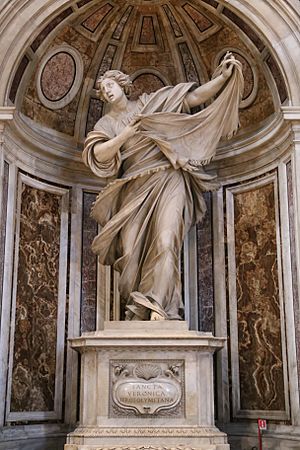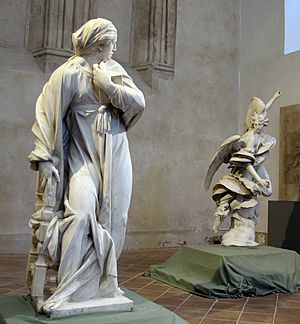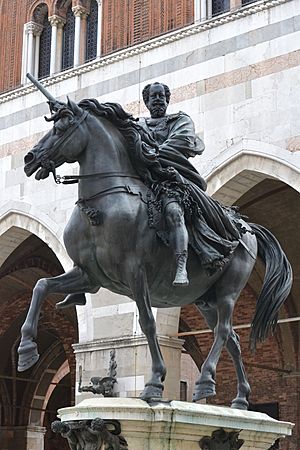Francesco Mochi facts for kids

Francesco Mochi (born July 29, 1580, in Montevarchi – died February 6, 1654, in Rome) was an Italian sculptor. He was one of the first artists to create sculptures in the Baroque style. He worked mostly in Rome, Piacenza, and Orvieto. His early works in Orvieto are often seen as the very first true Baroque sculptures.
Contents
Mochi's Early Career

Francesco Mochi first trained with a painter named Santi di Tito. From him, Mochi learned to value clear and precise drawing in art. This was also seen in the sculptures of Giambologna and his students. Even though Mochi was also a painter, none of his paintings are known to exist today.
Around 1599, Mochi moved to Rome. There, he continued his training with Camillo Mariani, another sculptor. Mochi worked with Stefano Maderno on an important project for the Pope. This was the Cappella Paolina in Santa Maria Maggiore. For this chapel, Mochi created a statue called Saint Matthew and the Angel.
His first big project was the Annunciation of the Virgin by the Angel. This work is made of two separate statues. The Angel was finished in 1605, and the Virgin Annunciate in 1608. These statues are now in the Museo dell'Opera del Duomo in Orvieto. Art experts like Rudolf Wittkower called it a very exciting work. It showed early signs of the dramatic Baroque style.
Bronze Statues and Later Works
Mochi was one of the few sculptors in the 1600s who was also a master at casting bronze. He made two amazing bronze statues of horsemen. These statues show Ranuccio I Farnese and Alessandro Farnese, Duke of Parma. They are located in Piazza Cavalli, Piacenza. The statue of Ranuccio Farnese was made between 1612 and 1620. The one of Alessandro Farnese was made between 1620 and 1629. These two works are considered some of the best of his career.
After working in Piacenza, Mochi returned to Rome. There, he finished his statue of Saint Martha. This statue was for the Barberini family chapel at Sant'Andrea della Valle. He had started it much earlier, between 1609 and 1621. By this time, another sculptor named Gian Lorenzo Bernini was very famous. Bernini was getting most of the big art jobs. His style was a fully developed Baroque, and Mochi's art felt a bit out of date compared to it. Mochi found it hard to get new commissions because of this change in style and his own strong opinions.
Some of his later works in Rome include Christ Receiving Baptism (made around 1635 or later) at Ponte Milvio. He also created Taddeus (1641–44) in Orvieto. His statues of Saints Peter and Paul (1638–52) are at the Porta del Popolo in Rome.
Saint Veronica in St. Peter's Basilica
One of Mochi's most famous works is the statue of Saint Veronica. It is one of four very large sculptures inside St. Peter's Basilica in Rome. This statue shows Saint Veronica holding the Veil of Veronica. This veil was believed to have the face of Jesus on it. Mochi worked on this statue from 1629 to 1640.
The other three large statues in this part of the basilica were made by other famous sculptors. These include François Duquesnoy (Saint Andrew), Gian Lorenzo Bernini (Saint Longinus), and Andrea Bolgi (St Helena).
Mochi's Saint Veronica is known for being very dramatic and full of movement. It stands out among the other statues. Bernini's Longinus is a mix between the calmer styles of Bolgi and Duquesnoy and Mochi's strong emotion. Mochi's statue shows a lot of passion. He once wrote that he worked very hard on it. He wanted it to be a memorable work from his later years.
People have become more interested in Mochi's art in modern times. An art show about him in 1981 helped bring his work to new attention.
See also
 In Spanish: Francesco Mochi para niños
In Spanish: Francesco Mochi para niños


